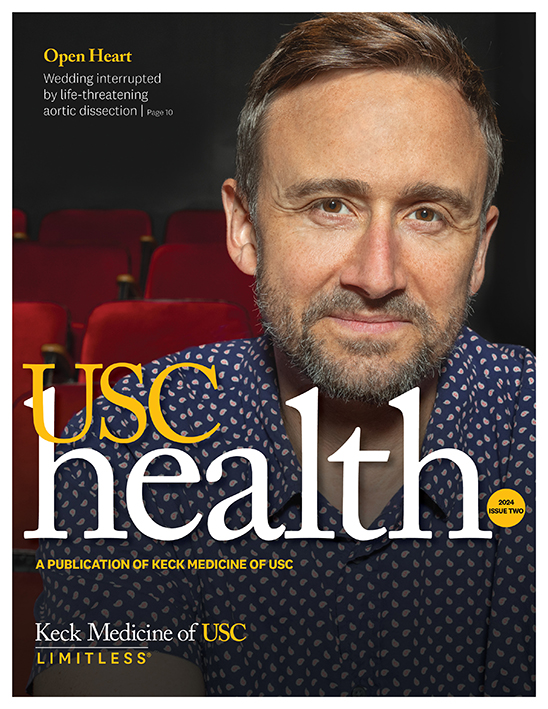
Melody LaTorre was pregnant when she learned she had brain cancer. In a race against time, a team of Keck Medicine of USC experts worked to save both mother and child.
Melody LaTorre and her husband Alberto had been trying to get pregnant. The spouses already had a young son, Malachi, and they wanted to grow their family.
When the couple learned Melody was expecting again after a miscarriage, they were overwhelmed with joy — and they vowed to monitor the pregnancy carefully.
Shortly into her second trimester, Melody, then 34, started experiencing strange symptoms. Her limbs were twitching, and her head was turning side to side on its own.
By week 20, Melody had developed foot drop, a condition in which the front of the foot doesn’t lift properly when walking. It is almost always caused by a neurological problem, so Melody’s chiropractor insisted she see a neurologist.
Melody complied, and her neurologist scheduled an MRI. As the South Pasadena couple drove home from the scan, they received a call to come back right away.
The news was frightening: Melody had a mass growing in her brain. And because the contrast dye used during MRIs can’t safely be administered to pregnant women, they weren’t able to tell exactly what the mass was.
State-of-the-art neuroimaging laboratory
Soon after Melody’s diagnosis, a family friend recommended that she meet with Arthur Toga, PhD, director of the USC Mark and Mary Stevens Neuroimaging and Informatics Institute.
Dr. Toga, who is also the director of the Keck School of Medicine of USC’s Laboratory of Neuroimaging, referred Melody to neurosurgeon Gabriel Zada, MD, director of the USC Brain Tumor Center at Keck Medicine of USC.
It wasn’t an easy journey, but we’re really grateful that we had the best care we could have received.
Melody LaTorre, patient, USC Brain Tumor Center
“We were really grateful we didn’t have to wait a long time,” Melody says.
By the time Melody met with Dr. Zada, he had already looked at her MRI, but the unclear image was impossible to diagnose.
Dr. Zada took her back to Dr. Toga, who had a state-of-the-art MRI machine in his lab. The result offered more detail, revealing that Melody’s mass was either a meningioma, which is a noncancerous tumor, or a cancerous glioma.
Still, it would take a surgical removal of the tumor to find out which one it was.
Urgent response to brain tumor results
A glioma is an aggressive tumor of the central nervous system that starts in the brain. It can occur at any age, and it’s uncommon enough to be classified as a rare disease by the National Organization of Rare Disorders.
The exact cause of gliomas is unknown, but studies have shown that genetics and female hormonal fluctuations can increase one’s risk.
Gliomas cause a host of critical symptoms, such as seizures, cognitive impairment, language problems and depression.

“Gliomas wind their way through the healthy brain,” says Frances Chow, MD, a neuro-oncologist at the USC Brain Tumor Center and an assistant professor of clinical neurological surgery and neurology at the Keck School.
“If there is any delay in treatment, the tumor can spread with deadly speed.”
Such urgency compelled Dr. Zada, who is a member of the USC Norris Comprehensive Cancer Center, to act sooner than he would have liked.
“It’s very hard to operate on pregnant women for brain tumors because you have to consider both fetus and mom,” Dr. Zada says. “Usually, we try to leave the baby in utero for as long as possible for the baby’s health. But Melody was getting worse.”
To help ensure the safety of Melody and her baby, Dr. Zada brought in Marc Incerpi, MD, a high-risk maternal-fetal specialist to consult on the surgery.
High-risk craniotomy delivers successful results
Melody says she didn’t have time to be scared. She drew strength from a commitment to be there not only for her unborn baby, but also for her older son.
Alberto was afraid. He knew his wife’s surgery, a craniotomy, would be extremely delicate.
And it was. “The tumor came within a millimeter of Melody’s motor fibers,” Dr. Zada says. “Any damage to those and she could have had permanent paralysis. These surgeries are like walking on a high wire.”
Thanks to Dr. Zada’s keen eye and steady hand, the surgery was a success. Melody spent three days recovering in the intensive care unit.
Soon after, she received the official diagnosis: The tumor was, in fact, a glioma, and it would require immediate chemotherapy. But doctors couldn’t begin treating Melody’s cancer until the baby was born.
“While we prefer to perform preterm births closer to 32 to 34 weeks of gestation, we had to think outside of the box in this case,” Dr. Incerpi says. “We did not want to deliver too early, which would be dangerous for the baby.”
The mother’s life was also at risk. Working with Laila Al-Marayati, MD, an OB/GYN who would perform the delivery, Drs. Zada and Incerpi made a shared decision to deliver Melody’s baby at the 27th week of pregnancy so the cancer treatment could begin.
Healthy baby born before lifesaving cancer treatment
To help the baby’s lungs develop as quickly as possible, Melody received a series of steroid shots. Then, her care team administered magnesium infusions to protect the baby’s brain.
A Caesarean section would be necessary due to the baby being in a breech position, but he was born breathing on his own — a feat that Melody’s doctors said was remarkable.
“The baby was vigorous and strong,” Dr. Al-Marayati says. “Melody was even able to see him before he went to the NICU.”
It didn’t take long for Melody and Alberto to come up with a name. To honor Dr. Zada’s lifesaving help, the couple decided on the neurosurgeon’s first name, Gabriel.
Upon hearing the news, “I almost started crying,” Dr. Zada says. “It was such a generous way to demonstrate her gratitude.”
Patients who have recovered from brain cancer are never considered in remission, but Dr. Chow confirmed that there is currently no evidence of the disease in Melody.
“Melody has recovered tremendously well,” says Dr. Chow, a USC Norris member who continues to monitor her patient’s health. “She brightens our days by sharing photos and hugs from baby Gabriel, and Malachi wants to be a neurosurgeon when he grows up.”
Adding to the family’s joy is the fact that Gabriel, now a toddler, is in excellent health.
“It wasn’t an easy journey, but we’re really grateful that we had the best care we could have received,” Melody says.
Topics


